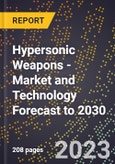Market forecasts by Region, Type, and by End-User. Country Analysis, Market and Technology Overview, Opportunities and Scenario Analysis, and Leading Company Profiles
A decade ago experiments started in the US with hypersonic weapons (speeds greater than Mach 5) but were initially not seen as an option to increase the strike capability enough to justify the cost. With the Chinese and Russians starting to develop hypersonic weapons, the US has renewed funding to continue the development for weapons and defense systems once again.
In the military domain, hypersonic technology is used to develop fast, manoeuvrable weapons that can strike targets quickly and with little warning. In the commercial aviation sector, hypersonic technology has the potential to enable the development of passenger planes that can travel at extremely high speeds, reducing travel times significantly.
Based on rigorous study of the capabilities of supersonic and hypersonic weapons and the growing impact this technology has caused in military environments, we've researched the market and technologies for Hypersonic Weapons. The study aims to achieve the following objectives:
- Demonstrate the importance of Hypersonic weapons for the military globally
- Relate the concept of interoperability of hypersonic weapons with man & unmanned systems
- Analyse and forecast the market size of the Hypersonic market in the US and globally
The following types of Hypersonic Weapons are researched:
- Land Attack Cruise Missile
- Air Launched Cruise Missile
- Anti-Ship Cruise Missile
- Hypersonic Glide Vehicle
- Surface to Air Missile
- Tactical Ballistic Missile
- Non-Missile Kinetic Penetrators
Segmentation
This report is segmented by Region, Calibre and User.
Region
- Americas
- Europe
- Asia
- Middle East
- Africa
Type
- Land-based platforms
- Air-based platforms
- Sea-based platforms
End-User
- Army
- Air Force
- Navy
Military spending for this technology is expected to grow as an overall percentage of large military budgets such as the United States’ defence budget and the Chinese defence budget, offering specialised missile manufacturers and software developers a tremendous opportunity.
Covered in this report
- Overview: Snapshot of the hypersonic weapon technology in the military market during 2022-2030, including highlights of the demand drivers, trends, and challenges. It also provides a snapshot of the spending with respect to regions as well as segments and sheds light on the emergence of new technologies
- Market Dynamics: Insights into the technological developments in the hypersonic weapon market and a detailed analysis of the changing preferences of governments around the world. It also analyses changing industry structure trends and the challenges faced by the industry participants.
- Segment Analysis: Insights into the various systems market from a segmental perspective and a detailed analysis of factors influencing the market for each segment.
- Regional Review: Insights into modernization patterns and budgetary allocation for top countries within a region.
- Regional Analysis: Insights into the systems market from a regional perspective and a detailed analysis of factors influencing the market for each region.
- Impact Analysis: Analysis on how certain events will impact the missiles market. This will give you an indication on which factors are important in the market forecast.
- Key Program Analysis: Details of the top programs in each segment expected to be executed during the forecast period.
- Competitive landscape Analysis: Analysis of competitive landscape of this industry. It provides an overview of key companies, together with insights such as key alliances, strategic initiatives, and a brief financial analysis
Reasons to buy
- Determine prospective investment areas based on a detailed trend analysis of the global Hypersonic weapon industry over the next eight years
- Gain in-depth understanding about the underlying factors driving demand for different systems segments in the top spending countries across the world and identify the opportunities offered by each of them
- Strengthen your understanding of the market in terms of demand drivers, industry trends, and the latest technological developments, among others
- Identify the major channels that are driving the global Hypersonic weapon business, providing a clear picture about future opportunities that can be tapped, resulting in revenue expansion
- Channelize resources by focusing on the ongoing programs that are being undertaken by the ministries of different countries within the Hypersonic market
- Make correct business decisions based on thorough analysis of the total competitive landscape of the sector with detailed profiles of the top systems providers around the world which include information about their products, alliances, recent contract wins and financial analysis
Table of Contents
Companies Mentioned
- Airbus
- Almaz -Antey
- BAE Systems
- Boeing
- Calspan Corporation
- China Aerospace Science and Industry Corporation
- Curtiss-Wright Corporation
- Denel SOC Ltd
- Dynetics
- General Atomics
- General Dynamics Corporation
- Hermeus Corp
- Israel Aerospace Industries
- Kongsberg Gruppen ASA
- Leonardo
- MBDA
- Nexter Group
- Northrop Grumman Corp
- Raytheon
- Reaction Engines
- Safran
- Tactical Missiles Corporation
- Textron Inc
- Thales








